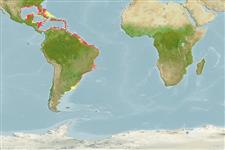Common names from other countries
Environment: milieu / climate zone / depth range / distribution range
Ecologia
marinhas; estuarina demersal; intervalo de profundidade 1 - 20 m (Ref. 36453). Tropical; 30°N - 44°S, 98°W - 26°W
Western Atlantic: Florida, USA and northern Gulf of Mexico to northern Argentina.
Length at first maturity / Tamanho / Peso / Idade
Maturity: Lm 11.1 range ? - ? cm
Max length : 33.1 cm TL macho/indeterminado; (Ref. 80009); common length : 17.0 cm TL macho/indeterminado; (Ref. 5217); peso máx. Publicado: 29.50 g (Ref. 118626)
Espinhos dorsais (total) : 0; Raios dorsais moles (total) : 52 - 58; Espinhos anais: 0; Raios anais moles: 39 - 44.
Adults occur mainly in brackish or hyper-saline lagoons (Ref. 5217), on sandy-muddy bottoms of estuaries and in the littoral zone where it hides itself leaving just its eyes out. Can easily disguise itself in the environment. Feed on worms, crustaceans and small fishes. Juveniles have a brief planktonic life, moving quickly to the benthic stage. Growth rate is relatively slow (Ref. 35237).
Life cycle and mating behavior
Maturities | Reprodução | Spawnings | Egg(s) | Fecundities | Larvas
Robins, C.R. and G.C. Ray, 1986. A field guide to Atlantic coast fishes of North America. Houghton Mifflin Company, Boston, U.S.A. 354 p. (Ref. 7251)
Categoria na Lista Vermelha da IUCN (Ref. 130435)
CITES (Ref. 128078)
Not Evaluated
Ameaça para o homem
Harmless
Utilização humana
Pescarias: espécies comerciais; Aquário: Espécies comerciais
Ferramentas
Relatórios especiais
Descarregue XML
Fontes da internet
Estimates based on models
Preferred temperature (Ref.
115969): 22.5 - 28.1, mean 27.2 (based on 937 cells).
Phylogenetic diversity index (Ref.
82804): PD
50 = 0.5020 [Uniqueness, from 0.5 = low to 2.0 = high].
Bayesian length-weight: a=0.01230 (0.01024 - 0.01478), b=3.14 (3.09 - 3.19), in cm Total Length, based on LWR estimates for this species (Ref.
93245).
Nível Trófico (Ref.
69278): 3.5 ±0.4 se; based on diet studies.
Resiliência (Ref.
120179): Médio, tempo mínimo de duplicação da população 1,4 - 4,4 anos (Preliminary K or Fecundity.).
Fishing Vulnerability (Ref.
59153): Low vulnerability (23 of 100).
